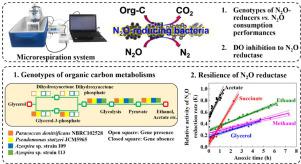Water Research ( IF 11.4 ) Pub Date : 2021-11-30 , DOI: 10.1016/j.watres.2021.117910 Chuang Qi 1 , Yiwen Zhou 2 , Toshikazu Suenaga 3 , Kohei Oba 2 , Jilai Lu 4 , Guoxiang Wang 5 , Limin Zhang 6 , Sukhwan Yoon 7 , Akihiko Terada 8

|
Harnessing nitrous oxide (N2O)-reducing bacteria is a promising strategy to reduce the N2O footprint of engineered systems. Applying a preferred organic carbon source as an electron donor accelerates N2O consumption by these bacteria. However, their N2O consumption potential and activity when fed different organic carbon species remain unclear. Here, we systematically compared the effects of various organic carbon sources on the activity of N2O-reducing bacteria via investigation of their biokinetic properties and genomic potentials. Five organic carbon sources—acetate, succinate, glycerol, ethanol, and methanol—were fed to four N2O-reducing bacteria harboring either clade I or clade II nosZ gene. Respirometric analyses were performed with four N2O-reducing bacterial strains, identifying distinct shifts in DO- and N2O-consumption biokinetics in response to the different feeding schemes. Regardless of the N2O-reducing bacteria, higher N2O consumption rates, accompanied by higher biomass yields, were obtained with acetate and succinate. The biomass yield (15.45 ± 1.07 mg-biomass mmol-N2O−1) of Azospira sp. strain I13 (clade II nosZ) observed under acetate-fed condition was significantly higher than those of Paracoccus denitrificans and Pseudomonas stutzeri, exhibiting greater metabolic efficiency. However, the spectrum of the organic carbon species utilizable to Azospira sp. strain I13 was limited, as demonstrated by the highly variable N2O consumption rates observed with different substrates. The potential to metabolize the supplemented carbon sources was investigated by genomic analysis, the results of which corroborated the N2O consumption biokinetics results. Moreover, electron donor selection had a substantial impact on how N2O consumption activities were recovered after oxygen exposure. Collectively, our findings highlight the importance of choosing appropriate electron donor additives for increasing the N2O sink capability of biological nitrogen removal systems.
中文翻译:

有机碳决定了进化枝 I 和 II nosZ 细菌的一氧化二氮消耗活性:基因组和生物动力学见解
利用一氧化二氮 (N 2 O) 还原细菌是减少工程系统 N 2 O 足迹的一种有前景的策略。应用优选的有机碳源作为电子供体加速了这些细菌的N 2 O消耗。然而,当饲喂不同的有机碳物种时,它们的 N 2 O 消耗潜力和活性仍不清楚。在这里,我们通过研究其生物动力学特性和基因组潜力,系统地比较了各种有机碳源对 N 2 O 还原细菌活性的影响。将五种有机碳源(乙酸盐、琥珀酸盐、甘油、乙醇和甲醇)喂入四种携带进化枝 I 或进化枝 II nosZ基因的 N 2 O 还原细菌。对四种 N 2 O 还原细菌菌株进行了呼吸测量分析,确定了 DO 和 N 2 O 消耗生物动力学因不同喂养方案而发生的明显变化。无论 N 2 O 还原细菌如何,使用乙酸盐和琥珀酸盐都可以获得更高的 N 2 O 消耗率以及更高的生物量产量。 Azospira sp.的生物量产量(15.45 ± 1.07 mg-生物量mmol-N 2 O -1 )。在醋酸盐喂养条件下观察到的菌株I13(clade II nosZ )显着高于脱氮副球菌和施氏假单胞菌,表现出更高的代谢效率。然而,固氮螺菌属可利用的有机碳物种的光谱。 菌株 I13 是有限的,正如用不同底物观察到的高度可变的 N 2 O 消耗率所证明的那样。通过基因组分析研究了补充碳源的代谢潜力,其结果证实了 N 2 O 消耗生物动力学结果。此外,电子供体的选择对氧暴露后N 2 O消耗活性的恢复具有重大影响。总的来说,我们的研究结果强调了选择合适的电子供体添加剂对于提高生物脱氮系统的 N 2 O 汇能力的重要性。











































 京公网安备 11010802027423号
京公网安备 11010802027423号